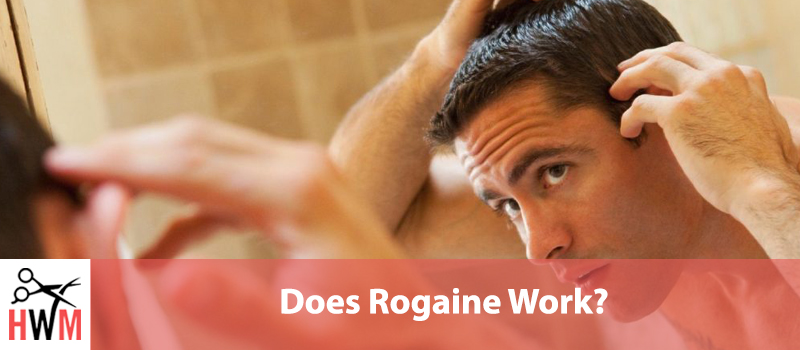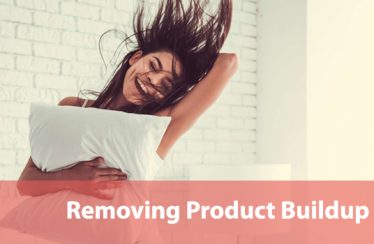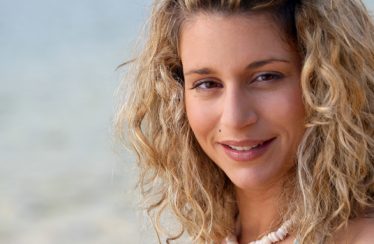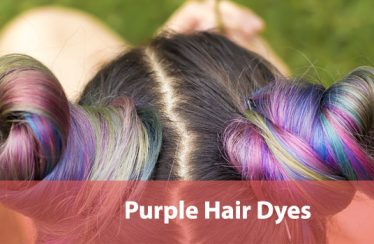Hair loss is never fun. More than the appearance changes and indications of advancing age, it’s also almost entirely out of your control.
You might keep a full head of hair most of your life, only to suddenly lose much of it over the course of only a couple years. Or, you might notice that you have slow and progressive hair loss starting early. Some men start experiencing male pattern baldness before they’re even in their 20’s.
Regardless of when the hair loss starts, or how severe it is, it’s natural to want to halt and even reverse the process.
That’s where Rogaine comes into the picture. Rogaine has been marketed as a miracle hair restoration therapy. It’s also been mocked as expensive and ineffective quackery.
So, what’s the truth about Rogaine? Does it work? Who does it work for? When can you expect to see results?
Rogaine Basics
Before we get into the specifics about Rogaine and what you can expect, it’s important to understand some of the background information about the product.
What is it?
Rogaine is the brand name of the drug Minoxidil, which was originally manufactured as a treatment for high blood pressure. While Minoxidil was an effective high blood pressure medication, it had an unexpected side-effect, patients began to grow unwanted hair while they were taking it.
Instead of scrapping the drug or choosing to treat the hair growth and continue marketing it as a blood pressure medication, Minoxidil was reformulated as a topical treatment for hair loss and branded Rogaine.
How Does it Work?
Well, like many drugs that have been re-purposed to take advantage of unexpected side-effects, the exact mechanism behind Rogaine’s effectiveness is unknown.
We do know the Rogaine encouraged your hair follicles to stay in the hair-production phase. Your hair follicles cycle through several phases as part of their natural function. The active growth phase is the most noticeable, it’s what allows your hair to grow, and determines how long individual strands of hair can get. After the growth phase your follicles will hold on to the hair for a while, and then eventually shed the strand before starting the next growth phase.
Rogaine is thought to widen your hair follicles, which is possibly why they stay active longer. Whatever the precise cause having a longer active growth phase means more of your follicles will be in that growth phase at once.
When Do You Start Seeing Results?
This is the all-important question. Unfortunately, you do need to show a little patience. If Rogaine will work for you (and it doesn’t work for everyone, more on that later), you’ll need to use it regularly for at least 4 months before you’ll see results.
That long wait time is caused by the length of your hair follicle phases. It’s a good thing to have long phases in the follicles on the top of your head because your hair only grows about half an inch a month, or 6 inches a year. And it only grows while it’s in an active phase.
The active phase, anagen, lasts between 2-7 years for most people.
The resting phase of your follicles, telogen, is about 3 months for most people, so it takes about 3 months for the hair follicles in the resting phase of their cycle to start growing hair again.
Male pattern baldness is, at least in part, a reaction in your hair follicles telling them to stay in the resting phase longer, or permanently, without going into the growth phase. Even with Rogaine encouraging your follicles to produce hair it still takes some time for the action to start.
How Effective is Rogaine?
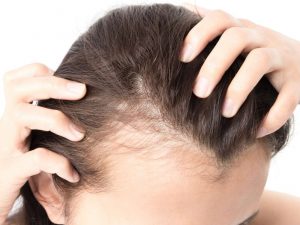
Unfortunately, your results are unpredictable until you’ve tried the treatment.
Some men get noticeable re-growth, with thinning sections of their hair thickening, and growing back some of the hair they’d completely lost.
Other men don’t see any results at all, or only get some fuzz not worth the cost of the treatment. At the end of the day, Rogaine works for about 60% of men.
Some factors can help you predict the kind of results you’ll see, which will help you decide whether it’s worth investing in the treatment.
Age
Rogaine is most effective for men under 40. It’s a bit unfair since many men don’t start to experience significant hair loss until after their 40’s, but it is true.
Part of this is just a natural effect of aging. Even in people who don’t notice significant cosmetic changes as a result of hair loss, aging still reduces the number of hair follicles that are active at any given point in time.
While male pattern baldness is more than just an age reaction, Rogaine is most effective when it’s only fighting male pattern baldness without also fighting the natural effects of age.
Rogaine also helps you keep the hair you have, so if you start the treatment younger, while you still have more hair, it has more to work with in the first place, giving you better long-term results.
That isn’t to say that older men can’t or won’t have great results with Rogaine, but you are less likely to see stunning reversals in your hair loss the older you are. If you’re over 40 you should also plan to try Rogaine for a longer period before you expect to see results.
Because the Rogaine is fighting an uphill battle to overcome both male pattern baldness and age it may take longer for a significant number of your hair follicles to re-enter an active phase, and your hair growth is also likely to be slower, taking longer for noticeable growth to appear.
Type of Balding
Another unfortunate reality is that Rogaine only works on certain types of balding. Specifically, it works on male and female pattern baldness (although with varying effectiveness. Congratulations, it works better for men), but not baldness as a result of illness or medication.
Rogaine is not suitable for baldness brought on by chemo.
You also shouldn’t reach for a bottle if you suddenly start losing your hair in chunks, or if your hair loss is very rapid, taking place over weeks and months instead of years.
Rapid hair loss can be a sign of something else wrong and should always be treated by a doctor so they can make sure the underlying cause is diagnosed and treated.
It also seems to be more effective for certain patterns of baldness. For instance, Rogaine will likely be more effective in restoring the hair at the crown of your head than restoring your hairline.
Fortunately, when it comes to hair loss around your hairline, Rogaine can protect the hair you have. If you start noticing thinning on your forehead, it’s probably worth your time to get some Rogaine early, before everyone else starts noticing too, so that you’re preserving your hair instead of trying to grow it back.
According to dermatologists, you’ll probably have lost ¼ to ½ of your hair before noticing cosmetic differences unless the loss is highly concentrated in one area. So, if you’re noticing the hair loss, it’s time to intervene.
How Long Should You Use Rogaine?
Rogaine is not a cure for male pattern baldness. The effective ingredients don’t build up in your system, correct hormonal imbalances, or turn off the genes causing the problem in the first place. So, once you start using Rogaine you should plan to continue using it. Indefinitely.
As I said, it isn’t a cure. The treatment is only effective for so long. If you stop using Rogaine, you will lose all the hair the Rogaine is responsible for.
That doesn’t mean that you’ll lose all of your hair, or that it will fall out if you miss a day or two here and there.
Instead, when you stop using Rogaine your hair follicles simply return to whatever state they would naturally be in.
You may lose your hair faster than normal for a little while, while follicles that were forced into the active phase stop growing and shed hair, but after that initial loss your hair will continue growing, and thinning, as normal.
That said, you can always resume using Rogaine if you decide you’re not as prepared for the hair loss as you thought you were.
Just don’t expect your results to be identical. Rogaine is protective, so it prevents a problem from developing in healthy hair follicles as much as it restores function to non-active follicles. Stopping and re-starting the treatment allows your hair thinning to progress the whole time you aren’t protecting your hair, and re-starting might not be able to reverse that process.
Can You Use Rogaine on Your Beard?
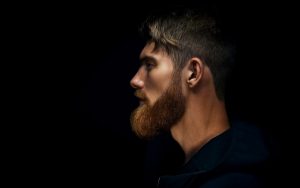
Generally, male pattern baldness, the condition Rogaine works best to treat, doesn’t affect your beard. In fact, you probably can grow a gorgeous thick beard, almost as if the hair from the top of your head migrated onto your chin.
However, some men do get baldness or thinning hair both places, or maybe you have a full head of hair, but struggle to grow a decent beard and are wondering if Rogaine could even out your results.
Unfortunately, this is another area where science isn’t in our favor. Mostly because studies on Rogaine use for beard growth haven’t been done.
The common wisdom is that Rogaine is unlikely to be a good option for beard growth much like it is better at restoring and retaining hair on the crown of your head than at the hairline. On the other hand, some men do see hair restoration along their hairline and even onto their foreheads, and other men have reported hair growth on the tops of their ears.
That extra, unanticipated, hair growth is an indicator that Rogaine might encourage hair growth outside normal application areas, like on your beard.
For safety’s sake, however, we cannot recommend that you use Rogaine on your beard.
The product simply hasn’t been studied for that use, and its current formulation is meant to be topical only, so you should avoid using it near your mouth or nose. Doing so increases the likelihood of accidentally ingesting the product.
If you are determined to use Rogaine, or another hair growth product, to try and enhance your beard growth you should consult with a licensed dermatologist before beginning the treatment. They’ll help you find product options as well as creating a grooming routine designed to help you get your dream facial hair.
Again, we do not recommend you use Rogaine on your beard without at least consulting a dermatologist first.
Rogaine Isn’t Always the Answer
As with any over-the-counter product, Rogaine is only a good solution for some men. Depending on your situation it may not be worth your time and money to give Rogaine a try. Here are some circumstances where we would recommend taking a trip to a doctor or dermatologist over buying Rogaine.
You’re 18 or Under
Sure, it might be tempting, given Rogaine is more effective for young men, to start a Rogaine treatment early. But you should at least be an adult before you start worrying about protecting your hair.
There are a couple of reasons for this, the biggest being that Rogaine only works on very specific types of hereditary hair thinning. If your hair is already thinning before your 20’s there’s a good chance something else is to blame.
Not only will Rogaine fail to address another cause of hair thinning but attempting to use Rogaine to address the problem may prevent you from getting the actual cause diagnosed and treated effectively and early.
Even if you’re concerned that you have hereditary male pattern baldness in your family (look at your mom’s relatives instead of your dad or his relatives, male and female pattern baldness are passed down on the X chromosome. You’re much more likely to have male pattern baldness if your maternal grandfather or maternal uncles have it), 18 or under is too early to attempt to protect your hair.
Instead, see a dermatologist and talk about other options to protect your hair for now, and develop a game plan.
You should also talk to your relatives with male pattern baldness and find out when they started to notice that their hair was thinning.
Factors like lifestyle, activity level, and diet influence hair growth and health, so your situation won’t be the same as theirs. Still, knowing when your relatives began to lose their hair can be a good indicator of when you should be concerned about the same.
Also, even with a family history of male pattern baldness, there’s no guarantee you have the gene that causes it. Better to wait and see than to spend a lot of money trying to prevent something you may not even have.
You Don’t Have a History of Male Pattern Baldness in Your Family
This is another situation where you might be better served by going to a dermatologist or doctor than your local pharmacy.
Like some of the other situations we’ve outlined, the reason for this is all about your health and the effectiveness of the product.
Rogaine works best for men with male pattern baldness, and while it may help with some other causes of hair thinning and hair loss, it certainly won’t work for all of them.
Besides that, if you don’t have a history of hereditary male pattern baldness and suddenly start losing your hair, something else may be causing the hair loss. While you may just have had the unfortunate luck of being the first guy in your family to get stuck with the bad-hair gene, better to get looked over to make sure nothing more serious is to blame.
Your Hair Loss is Related to Product Use, Hairstyle, or Other Damage
Adding another product to address the damage caused by your current product use, grooming routine, or hairstyle just isn’t going to help.
It can be hard to know exactly what is at the root of your hair loss, but there are some signs of damage caused by habits vs genetics.
Your Hair Loss Follows the Pattern of Your Hairstyle
Cornrows and other tight braided hairstyles look great on a lot of guys. Braids can even be a protective hairstyle for certain types of hair.
But if your hair is starting to thin or fall out, and the thinned patches follow the pattern of your braid rather than a more typical balding pattern, chances are your hairstyle is part of the problem.
That isn’t to say you need to stop braiding your hair, far from it. If you want to keep the braids, but ditch the hair loss, talk to your hairdresser, stylist, or braider. They might be able to suggest a looser style that would minimize hair damage.
Other solutions include changing the pattern of your braid every time you get it re-done. Changing the pattern moves the areas of highest stress, giving your hair follicles a break and time to recover.
You might also want to give your hair a total break between braids. Wear it completely loose or tied back in a low tail for a few days before you get it re-braided. This helps for the same reason changing patterns can help, it gives your hair follicles some time to recover.
If those options don’t help, then it might be time to ditch the braids and cornrows. Again, talk to your stylist and see if they have suggestions for new hairstyles or ways to handle the effects of your braids.
Your Product Makes Your Scalp Burn or Itch
Even if your favorite hair products aren’t causing more obvious problems like dandruff, a burning or itchy scalp is an indication that the product isn’t a good option for you.
Avoid products that cause any kind of irritation, even mild or short-duration problems. Over time that irritation can cause damage to your hair follicles, clog the pores on your scalp, and weaken or thin individual hair strands.
All that damage translates to thinner hair and can contribute to or cause hair loss.
When you can, it’s a good idea to buy sample or travel-sized products to try them. Make sure you don’t have any discomfort when you use them.
You should also plan on using any product less if you’ve noticed irritation or hair loss from one. You need to give your scalp and hair time to recover, and even gentle products can get in the way.
If you have a hairstyle that needs gel, mouse, spray, or other products every single day you should consider getting a different cut, at least for a while. Once your hair has recovered you can experiment with going back to heavy product use but stick to gentler formulations and try to minimize direct contact between the product and your scalp.
How to Use Rogaine
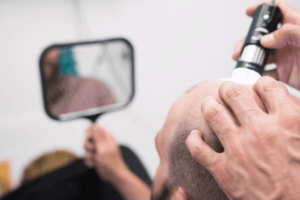
Now that we’ve talked about what makes you a good candidate for Rogaine, and situations where a different solution might work better, you probably want to know how to use Rogaine.
You can buy Rogaine in two different strength formulations, 2% if you don’t need much in the way or re-growth or protection, and 5% for more drastic hair loss.
You can also choose between two different types of products, a foam or a serum. This is entirely based on personal preference and which you think would be easier to apply and control, both options are equally effective.
Whichever formulation and product you go with, you will want to apply it twice a day. It’s usually easiest to add it to your morning and before bed routines. The biggest trick to application is that your hair mustbe either completely dry or slightly damp. Rogaine doesn’t work as well if you apply it with wet hair.
Your hands should be completely dry, and clean.
The exact amount you should use depends on which version of Rogaine you go with, but it’ll tell you on the bottle.
You don’t want to just smear it on your head and leave it. Go ahead and take some time to massage it gently into your scalp. Not only does massaging it help make sure the product is fully absorbed into your skin, scalp massage also helps bring blood flow to your scalp and can be part of an effective hair loss treatment on its own.
You can apply either to the immediate area of hair loss or to your whole head. Remember that Rogaine also works to protect and preserve the hair you already have, and is generally better at protection than true re-growth.
You should also remember that, even in ideal circumstances, Rogaine only works for about 60% of men. If you aren’t seeing results within 4-6 months of use, it’s probably time to seek help from a dermatologist.
